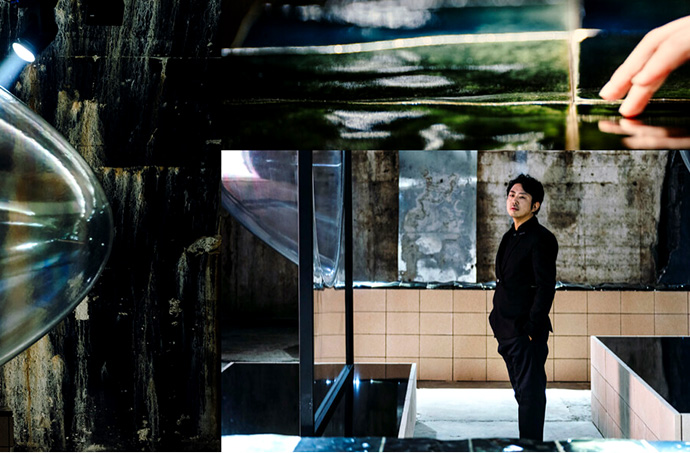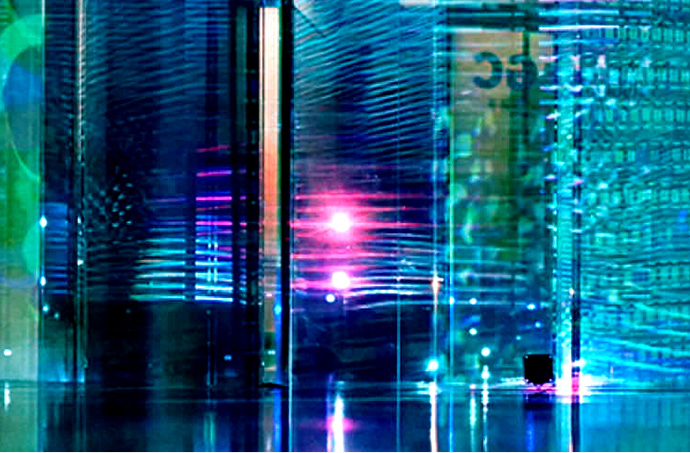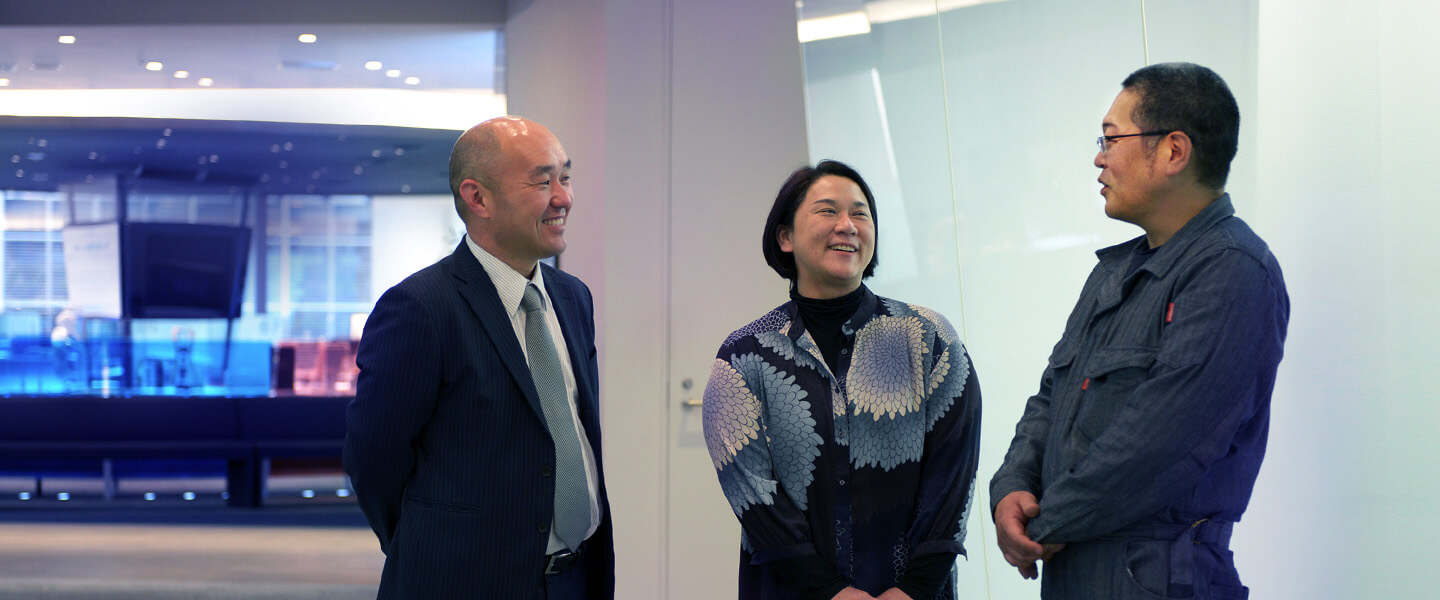
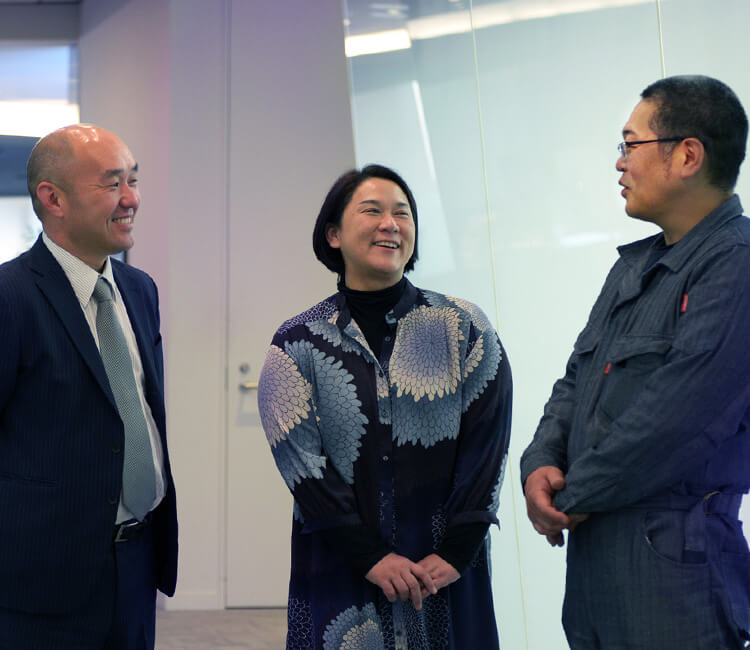
Lexus LS takes on a new challenge — bringing exquisite glass and Japanese craftsmanship to the world
- #Mobility
- #Collaboration
- #Design
Lexus LS 500 and LS 500h launched in October 2017. In a style befitting flagship models, the two models symbolizing the brand’s transformation offer a decorative interior trim option based on Japanese craftsmanship, which features cut-glass in the style of Kiriko, a traditional Japanese glass-decorating technique, combined with handcrafted pleats on the door trim. This world-first offering (based on a survey by AGC as of October 2017) was a feat achieved through the collaborative efforts of many, including designers, craftsmen, and engineers.
At the heart of this project were Junko Itoh from the Lexus Color Design Dept. Design Development Div., glass artisan Toshiyasu Nakamura who runs STUDIO KOBIN, and Hideki Ishioka of AGC. These three, who rose to the challenge of creating new value, share behind-the-scenes episodes of the development, from the start of the project to its completion.

Junko Itoh The Lexus brand has been experimenting with various approaches under the theme “Takumi Craftsmanship” to grow as a Japanese luxury lifestyle brand. In designing LS 500 and LS 500h, we particularly wanted to express three worlds: one of timeless universality where one could feel an attachment for the car for many years, another of ultimate pinnacle where conventional industrial design is pursued to its purest form, and a world of mysterious sensuality created by the resonance of light. For the world of sensuality, we tried to create a space where the light coming into the car would reflect and resonate with the interior design. That is how we landed on the combination of handcrafted pleats and Kiriko-style cut-glass for the door trim panel.

Junko Itoh from the Lexus Color Design Dept. Design Development Div.
Glass had rarely been used as a material in automotive ornamentation, largely because of the difficulty in ensuring its safety and the challenges in industrial production. However, AGC presented us with an excellent product that could be feasible, and the development started. We went back to AGC and said that we wanted to produce a space filled with light in rainbow colors created from the refraction of light by prisms.
Hideki Ishioka AGC has manufactured and supplied automotive glass for car windows for many years. However, we felt that we could further expand the possibilities and applications of glass, and so we held a small exhibition specifically for Toyota, the parent company of Lexus, in the fall of 2013. One of the proposals we presented was to use glass for the interior of the car, since we already had the technology for sophisticated molding and reinforcing of glass.
After the project started, we received a request that they wanted to try cut-glass using the Kiriko technique to express one of their themes, the rainbow colors. But we had no one nor any organization in AGC that could produce such designs. And so we reached out through various contacts and finally met Mr. Nakamura, who is a glass artisan. Working with decorative glass, as well as developing a team to work on it, was a first in the 110 year history of AGC.
Toshiyasu Nakamura AGC came to me and asked if I would let them explain the concept of the project, so I went to Toyota City in Aichi Prefecture, where Toyota is headquartered. They wanted to use Kiriko-style glass for the car interior trim, and so I became involved as the designer to create a prototype. This was the first time I had worked with big car and glass manufacturers, so it was a new challenge for me as well.
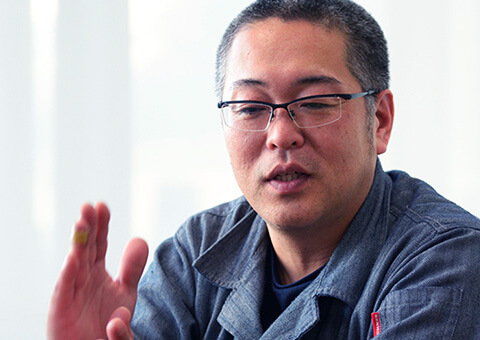
glass artisan Toshiyasu Nakamura who runs STUDIO KOBIN
The project kicked into gear in the summer of 2014. Mr. Nakamura first hand-carved a prototype based on a design proposal provided by the Lexus team. He had to create lines and cuts both beautiful and effective at producing rainbow-colored reflections in the car.
Nakamura Glassware such as cups and plates are held and moved in the hand, so you can see the changing lights as you handle them. On the other hand, auto parts are installed in a fixed position, so I wanted to make sure that it was possible to enjoy the reflecting light in whatever situation, whether it was on opening or closing the door, or during the time of the day when it would be catching the morning sun or the evening sun. For this reason, I tried not to use simple cut lines, but introduced angles and twists into the design. At the same time, I was conscious of not making the design too complicated, to make sure that it was possible for AGC to mass produce it.
Itoh In order to produce prismatic reflections, the cuts needs to have a certain depth and angle. At the same time, you also need to give consideration to vehicle weight and strength. In terms of weight, the thinner the glass the better, but then that would be detrimental to safety and would also take away depth from the reflections. We examined this issue from a variety of perspectives and finally decided on a thickness of five millimeters, which satisfied our requirements for aesthetics, weight, and safety. We ended up asking Mr. Nakamura to create more than a dozen prototypes until we reached the final prototype.
It was AGC’s job to convert the Lexus team’s design proposals and Mr. Nakamura’s ideas into a manufacturable product. As this was a first-time endeavor, AGC had to face a series of challenges.
Ishioka For AGC, a big hurdle was that we had never previously manufactured decorative parts for cars. If it were glass car windows, where we had accumulated extensive experience over the years, we could ensure quality control against scratches and for transparency. But the quality for this project was measured in terms of “aesthetics” for which we had no know-how. We were not sure what we could use as criteria for judgment. Because the reflection of the light or the beauty of the shapes and forms were not quantified, we did not have a common language that would enable us to share such information across all staff members. From there, we had to define quality standards for a decorative part through trial and error, including the appropriate thickness, shine of the surface, and roundness of the ridges of the Kiriko cuts. These were all things that we were learning for the first time as we went along.

Hideki Ishioka of AGC
Roughly eighteen months later, after many twists and turns, the final sample of the prototype was finally completed. To manufacture the panel, a press form technology to press a flat glass onto a mold was used. In order to faithfully reproduce Mr. Nakamura’s craftsmanship, digital data technology including 3D scanning and CAD were used in this process.
Ishioka Simply creating digital data of Mr. Nakamura’s prototype was not so difficult. However, the lines cut in the prototype have subtle fluctuations and twists specific to handmade products, which were hard to translate into a mold and which would also cause issues in the press forming process. Because of this, we had to make adjustments to the details repeatedly after scanning. Our staff really struggled with revising the surfaces in particular. If we let productivity take priority, then we would lose Mr. Nakamura’s touch and flavor. The number of surfaces and lines was so massive that the final set of panels for one car (a total of four panels, including those for both front and rear seats) ended up consisting of several thousand surfaces.
Nakamura When creating the prototype, I had to make sure that the shape of the lines matched the panel, because the panel itself had a complicated shape. But that was something I could do because it was handmade. I am sure it must have been very challenging for AGC, who had to create a mold from that. However, I was very surprised with the press-formed panel. Although they said they digitally revised the design, there were no drastic changes and the finished panel was very close to the original prototype.
Itoh Because we felt that Mr. Nakamura’s prototype had a handmade feel to it, we wanted AGC to reproduce that feel as much as possible. When I first saw the press-formed glass, I commented, “Isn’t the finish too neat?” without knowing the amount of trouble they had been through. Once I saw the scanned data though, I could see how they made the panel manufacturable while also highlighting Mr. Nakamura’s touch and flavor. I renewed my awe for the amazing craftsmanship and AGC’s amazing ability to reproduce that.
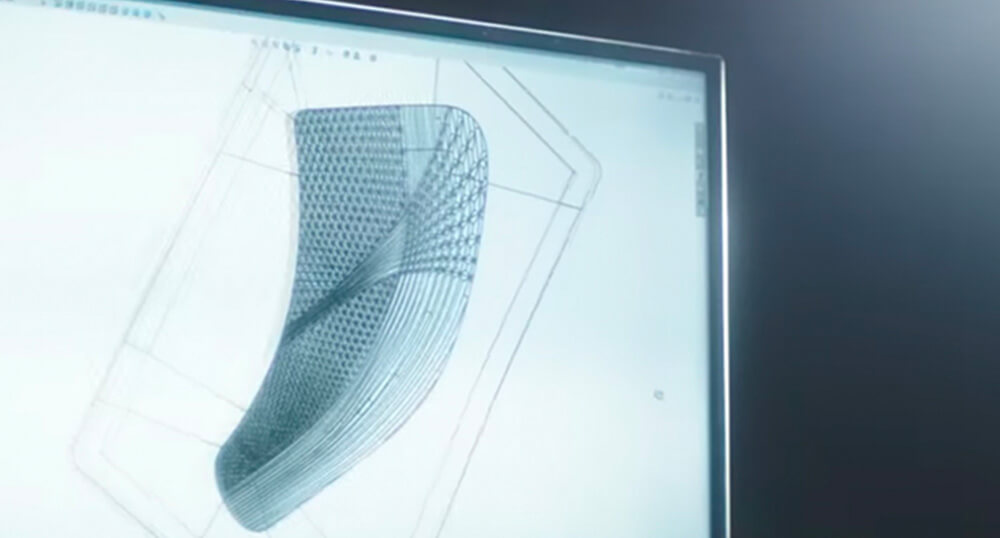
AGC reached out to glass fabricatorsacross Japan with advanced processing technologies to work together with them on this project, and prepared for production, including glass press forming, grinding, polishing and vapor deposition. In addition, they also made sure to incorporate strong safety measures, such as chemical reinforcement, shatterproof film, and a module to protect the outer edge. It certainly took aesthetics and safety to new heights.
Itoh After all, maintaining a high level of safety is critical when using glass for automotive interior trim. We checked the safety standards at Toyota many times during the development, but surprisingly, had no reports of failure.
Ishioka In order to increase the strength of the glass, we treated it with chemical reinforcement. Of course, the glass itself was infused with reinforcement material and we added a resin module to increase the strength also from a structural perspective. Actually, we initially had trouble finding a fabricator to form the resin module. It has a complicated shape, and no one had ever made a module for Kiriko-style glass to begin with. Together with other processes, we were able to realize this panel thanks to so many fabricators lending their generous support.
Nakamura Usually, I work in a self-contained manner, working on all processes and making all decisions by myself. That is why when I first became involved with the project, I was expecting to have a lot of constraints and not much freedom. As it turns out, the feeling of creating something beautiful and of taking on a new challenge was the same as how we would usually feel. Industrial production did not mean that we simply left it up to the machines to do all the work. Actually, the contribution of the individuals or teams had a significant impact. In that sense, you can say this product is also a craftwork. We were able to produce a literal embodiment of Japan’s “monozukuri,” or the Japanese way of manufacturing.
Itoh The whole team was able to share a positive attitude of “how can we make this happen?” from beginning to end. Because the others had much more specialist knowledge of glass than me, it was possible for me to delegate parts of the work while sharing the intention and goals of the design. I believe this naturally resulted in us working well as a team, and so we were able to produce something that we can boast can only be made in Japan.
Ishioka If this project had a policy of making things precisely according to instructions, I do not think it would have succeeded. There was a real sense of collaboration, that we were creating something together. Having this opportunity to work with people from other fields also gave me insight into their perspectives and senses, which once again made me aware of the values that glass offers, other than transparency and durability. To work with glass with the mindset that “beauty is itself a functionality” made me realize again that glass is a wonderful material. Going forward, I hope that I can give more attention to its beauty and expand its use in a variety of applications, thinking outside the box, based on the notion that glass is simply beautiful.

The merging of Japanese craftsmanship and industrial production was realized after overcoming a number of difficulties. This project, which achieved a feat that was a first in the world, became a trailblazer for a new path in manufacturing.
Ishioka This project owes its success not only to the Lexus team, Mr. Nakamura, and the AGC group, but also to all the fabricators who gave us their cooperation. Even within AGC, it was also not only the production and quality control teams that contributed, but so many members including those from design, logistics, performance evaluation and materials procurement all worked together towards the goal. You can say that this panel is a product filled with technology and wisdom from monozukuri, or the Japanese way of manufacturing. I hope people will actually touch the panel and feel the value offered by Japanese products.
Nakamura This project was full of new challenges, but I feel having this opportunity and experience will lead to a new, wider world. Glass is a material, like an unpolished gemstone. As such, it has unlimited possibilities. That is why I believe that if AGC, a manufacturer handling this unpolished gemstone, and Lexus, who decided to leverage its appeal in a new area of automotive interior trim, as well as all the fabricators commit to it, they will produce something phenomenal that is different from what we artisans would make. I hope I myself can continue to enjoy such possibilities.
Itoh After the announcement of the new LS 500 and LS 500h, in addition to Japan, we also received praise from other countries complimenting their beauty. Hearing these comments, I believe we were successful in presenting new value in the interior space of the car, and once again, I feel that true beauty transcends national borders and languages. If I may add to the value that the LS 500 and LS 500h offer, there is also the opportunity they provide for experiencing traditional Japanese craftwork. This exactly represents the Lexus brand’s philosophy to present value that affects people’s lifestyles through the car. Thanks to everyone involved in this project, we were able to create a product that symbolizes this world view.
In addition to convenience, safety, and security, decorative glass also delivers new value of beauty and charm that appeals to our senses and emotions, adding rich colors to our lives. With the success of this project, we may start to encounter more applications that show us the possibilities of glass, in a wider variety of places.







